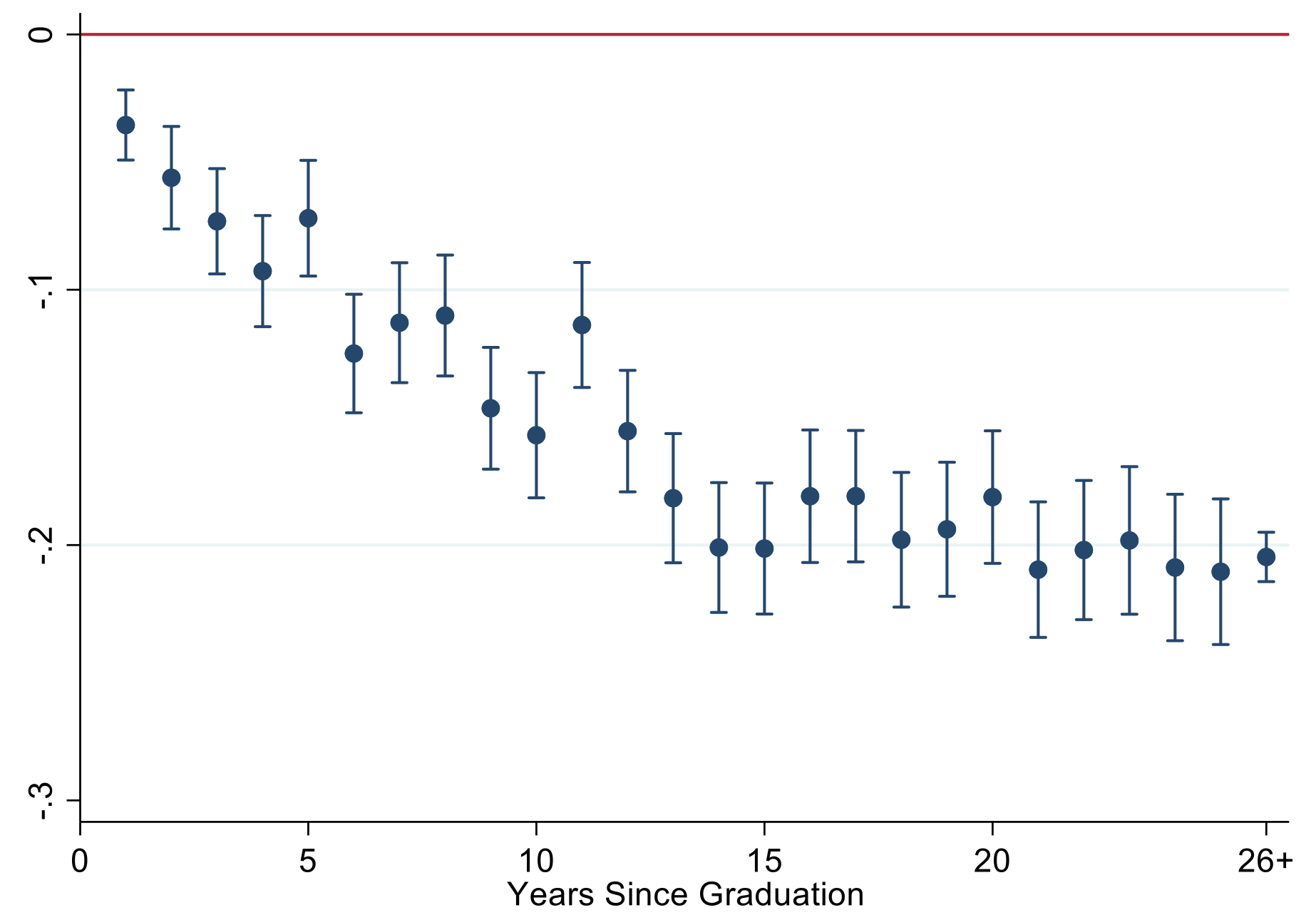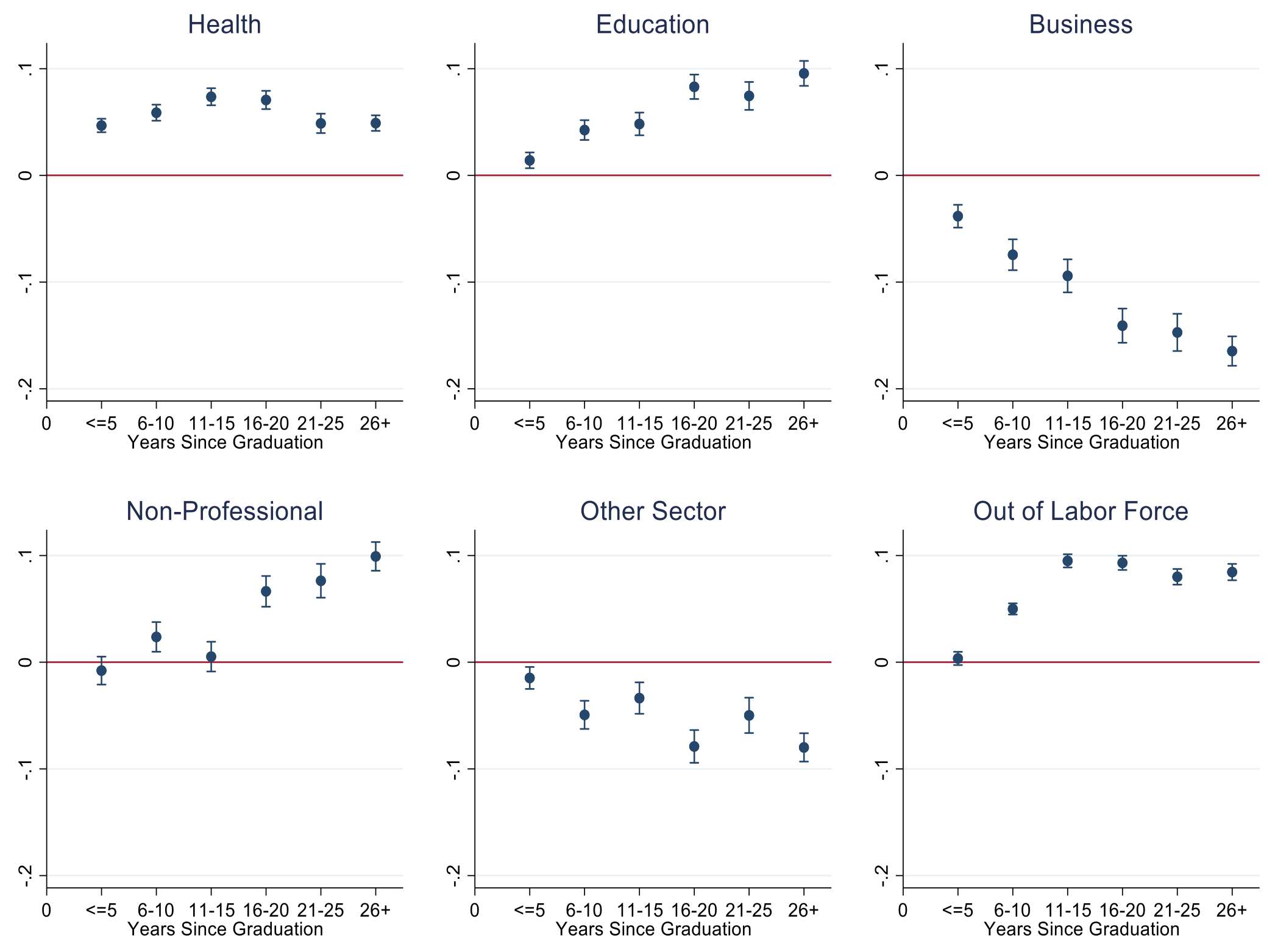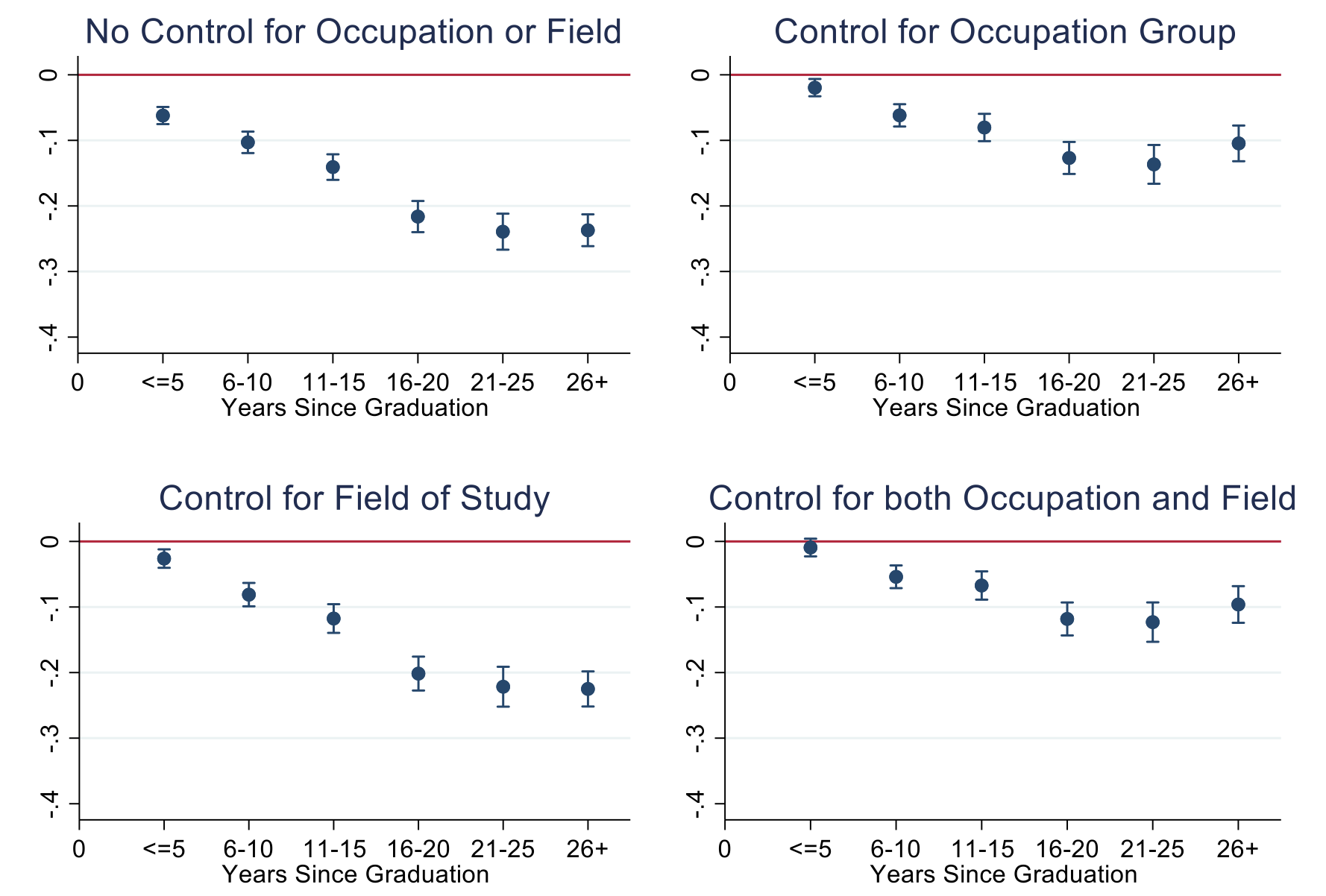Women are underrepresented in science, technology, engineering, and mathematics (STEM) jobs and occupations. This gender gap in STEM has important implications for society and the economy as it is widely agreed that having an adequate supply of STEM graduates is important for both innovation and economic productivity (Peri et al. 2014). In addition, given the typically larger earnings of STEM workers, having more women working in STEM jobs may help to decrease the gender gap in earnings (Card and Payne, 2021).
Given the importance ascribed to increasing female representation in STEM, a large literature has tried to understand the reasons for gender differences in STEM uptake at both the high school and college level (Kugler et al. 2017, Speer 2017, Delaney and Devereux 2019). However, there is relatively little work analysing gender gaps in STEM conditional on studying a STEM field in college. While understanding why women are less likely to study STEM subjects in high school and college is crucial to increasing the supply of female STEM graduates, it is equally important to understand what happens to women who choose to study STEM in college. Are they less likely than male STEM graduates to work in STEM and how does this evolve over the life cycle? In our recent study (Delaney and Devereux 2022) we examine this question using UK Labour Force Survey (LFS) data.
Transition from STEM undergraduate to post-graduate degrees
Prior to, or shortly after entering the labour market, STEM graduates may switch out of STEM by pursuing post-graduate degrees in non-STEM fields. We find that, among holders of a STEM primary degree, women are more likely than men to pursue a non-STEM Master’s degree. This is not just because they are more likely to do any Master’s degree – when we condition on graduating with a Master’s degree, female STEM undergraduates are around 7 percentage points less likely to do a Master’s in STEM than their male counterparts. The precise field of study of undergraduate degree can explain 35% of this gap, but even after controlling for high school and undergraduate achievement, female STEM graduates are still over 4 percentage points less likely to do their Master’s in STEM. It is clear that, even at this initial stage of the STEM pipeline, women are relatively more likely to exit STEM.
Persistence in STEM in the labour market
We now turn to the dynamics of STEM persistence over the life cycle for STEM graduates who are in the labour market. We focus on graduates whose highest degree is a Master’s or undergraduate degree in STEM and trace out the gender gap in working in STEM for each year since graduation. Figure 1 shows that female STEM graduates are much less likely to work in STEM occupations than are male graduates. This finding emerges right after graduation, with females being about 4 percentage points less likely to work in STEM. The difference gradually increases for the next 13 years and then flattens out so that after about 14 years post-graduation, female STEM graduates are approximately 20 percentage points less likely to work in STEM. Clearly, even for STEM graduates, there is a large gender gap in working in STEM occupations.
Figure 1 Gender differences in probability of STEM graduates working in STEM
Note: Each point represents the female coefficient from a regression of employment in STEM on a set of controls, and the upper and lower bars represent the 95% confidence interval. The outcome is unconditional on employment and controls include an age quadratic, indicators for white,for whether the highest degree is undergraduate or master’s, indicators for whether the degree is in life sciences, hard sciences, medical, engineering, architecture, math, or technology, and survey year fixed effects. The sample years are 1997-2021 and the year of graduation is 1970-2020.
Where do people move to if they leave STEM?
We now turn our attention to the sectors that graduates who leave STEM switch into and whether there are systematic differences by gender. We categorise the non-STEM sectors as health, education, business, low-skilled (or non-professional), or ‘other’. The other sector includes occupations such as journalists, police officers, and career advisers. Figure 2 shows that women are much more likely to switch to work in the education and health sectors while men are more likely to work in business and other sectors. As we discuss next, this gender difference in propensity to work across different sectors has important implications for the gender pay gap.
Figure 2 Gender differences in probability of STEM graduates working in different sectors (conditional on not working in STEM)
Note: Each point represents the female coefficient from a regression of employment in each sector on a set of controls, and the upper and lower bars represent the 95% confidence interval. The outcome for working in each sector is conditional on not working in STEM and controls include an age quadratic, indicators for white, for whether the highest degree is undergraduate or master’s, indicators for whether the degree is in life sciences, hard sciences, medical, engineering, architecture, math, or technology, and survey year fixed effects. The sample years are 1997-2021 and the year of graduation is 1970-2020.
Effect of persistence in STEM on the gender pay gap
Given that STEM jobs are typically higher paying, and women are less likely to work in STEM, we examine the effect of occupation on the gender pay gap for STEM graduates. Figure 3 shows how the gender gap in log hourly pay evolves over the career. We find that controlling for occupation has a meaningful impact on the gender pay gap at all phases of the lifecycle. For example, the addition of occupation controls reduces the gender gap for log hourly pay at 6-10 years post-graduation from 10 to 6 percentage points, and from 14 to 8 percentage points at 11-15 years post-graduation. The effect of occupational controls is even larger at later years in the career, with the gender gap in log hourly pay reducing from 24 percentage points to 13 percentage points between 21 and 25 years after graduation. Interestingly, the effect of field of study on the gender wage gap is much smaller than that of occupation and adding controls for the field of undergraduate study has a relatively small effect on the gender gap.
Figure 3 Gender gap in log hourly pay
Note: Each point represents the female coefficient from a regression of log hourly pay on a set of controls, and the upper and lower bars represent the 95% confidence interval. Controls include an age quadratic, indicators for white, for whether highest degree is undergraduate or master’s, and survey year fixed effects. Occupation group refers to 3-digit SOC groupings interacted with indicators for year in which SOC classification was used. Field of study refers to whether the STEM degree is in life sciences, hard sciences, medical degree, engineering, math, technology, or architecture. The sample years are 2005-2021 and the year of graduation is 1970-2020.
Conclusion
Increasingly, government policies aim at encouraging women to study STEM degrees in school and in college. This is based on the presumption that female STEM graduates will go on to work in STEM careers and thus help to contribute towards technological innovation and also mitigate the gender pay gap, as STEM workers earn higher wages. In this column, we show that such policies may have lower returns than expected due to the tendency for female STEM graduates to leave STEM at early stages of their career. This begins in the educational system – we find that, conditional on pursuing a Master’s degree, and controls for undergraduate achievement and field of study (within STEM), female STEM graduates are over 4 percentage points less likely to do their Master’s degree in STEM. Gender differences in STEM persistence are also evident in the labour market – in the first year after graduation, the gender gap in working in STEM is 4 percentage points and this slowly increases to around 20 percentage points 14 years post-graduation and then flattens out.
We also find that women who leave STEM jobs tend to switch to low-paying sectors such as education and non-professional jobs, while men who leave STEM tend to enter the more lucrative business sector. Finally, we see that the lower likelihood of women working in high-paying occupations can explain up to 50% of the gender gap in hourly pay for STEM graduates, with the size of the effect increasing over the life cycle.
Our findings suggest that policies that aim at increasing the proportion of women studying STEM in high school and college may have lower effects than expected due to the lower attachment of females to STEM after graduation. The results also caution against affirmative action policies such as gender points that give women an advantage in college admissions to STEM programmes if some female STEM graduates (and most likely, those at the margin) are not likely to work in STEM. On the other hand, if the reason women are leaving STEM jobs is due to lack of women in their jobs or to discrimination, then increasing the supply of female STEM graduates may help to prevent the flow of female graduates out of STEM jobs. Overall, policy may benefit from augmenting current attempts to attract women into STEM with efforts to tackle the greater propensity of women to exit STEM throughout the career.
References
Card, D and A A Payne (2021), “High School Choices and the Gender Gap in STEM”, Economic Inquiry 59: 9-28.
Delaney, J M and P J Devereux (2019), “It’s not just for boys! Understanding gender differences in STEM”, VoxEU.org, 19 April.
Delaney, J M and P J Devereux (2022), “Gender Differences in STEM Persistence after Graduation”, forthcoming in Economica.
Kugler, A, C Tinsley, and O Ukhaneva (2017), “Why there aren't more women in STEM fields”, VoxEU.org, 2 November.
Peri, G, K Shih and C Sparber (2014), “How highly educated immigrants raise native wages”, VoxEU.org, 28 May.
Speer, J D (2017), “The gender gap in college Major: Revisiting the role of pre-college factors”, Labour Economics 44: 69–88.






